chapter9心理语言学
- 格式:ppt
- 大小:2.48 MB
- 文档页数:5




英语语言学概论第九章笔记Chapter 9 Psycholinguistics 心理语言学1.The biological foundations of language 语言的生理基础a)The case of Phineas Gage 盖奇案例One afternoon in September 1848, a tragedy happed to Gage. A huge metal rod had gone through the front part of Gage’s brain, but his langua ge abilities were unaffected.The point of this amazing case is that, if our language ability is located in the brain, it is clear that it is not situated right at the front.1848年9月的一个下午,有一名叫菲尼亚斯.盖奇的美国人身上发生了一场悲剧。
一根大铁杆穿过了盖奇的大脑的前部,但他的语言能力却未受影响。
这一令人惊异的案例的意义在于,如果我们的语言能力位于大脑中,很显然不在其头部。
b)The human brain 人的大脑The human brain is the most complicated organ of the body. Lying under the skull, the human brain contains an average of ten billion nerve cells called neurons.人的大脑是人体最复杂的器官,它位于头盖骨下,平均包含有一百亿个神经细胞,即神经元。
The most important part of the brain is the outside surface of the brain, called the cerebral cortex. The cortex is the decision-making organ of the body, receiving messages from all the sensory organs and initiating all voluntary action. Many of the cognitive abilities that distinguish humans from other mammals, such as sophisticated reasoning, linguistic skills, and musical ability, are believed to reside in the cortex.大脑最主要的部分是它的外表面,这一外表面称为大脑皮层。
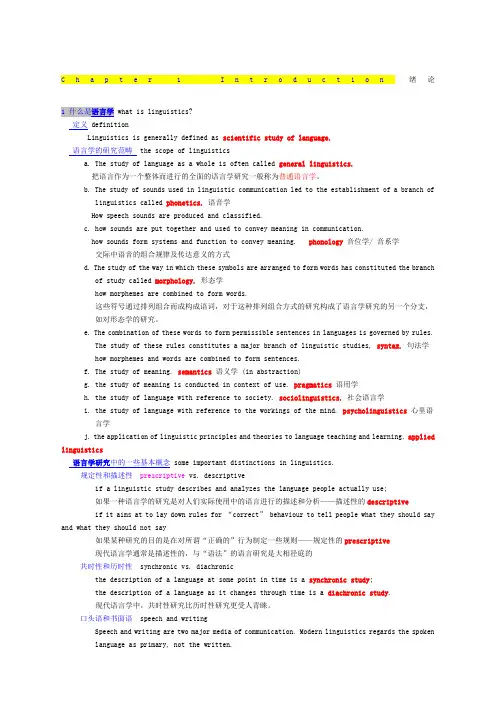
C h a p t e r1I n t r o d u c t i o n绪论what is linguistics?定义 definitionLinguistics is generally defined as scientific study of language.语言学的研究范畴 the scope of linguisticsa. The study of language as a whole is often called general linguistics.把语言作为一个整体而进行的全面的语言学研究一般称为普通语言学。
b. The study of sounds used in linguistic communication led to the establishment of a branch oflinguistics called phonetics.语音学How speech sounds are produced and classified.c. how sounds are put together and used to convey meaning in communication.how sounds form systems and function to convey meaning. phonology音位学/ 音系学交际中语音的组合规律及传达意义的方式d. The study of the way in which these symbols are arranged to form words has constituted the branchof study called morphology.形态学how morphemes are combined to form words.这些符号通过排列组合而成构成语词,对于这种排列组合方式的研究构成了语言学研究的另一个分支,如对形态学的研究。
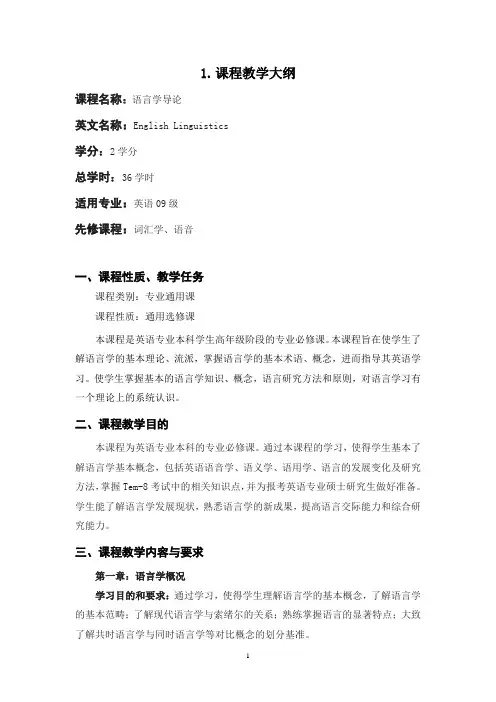
1.课程教学大纲课程名称:语言学导论英文名称:English Linguistics学分:2学分总学时:36学时适用专业:英语09级先修课程:词汇学、语音一、课程性质、教学任务课程类别:专业通用课课程性质:通用选修课本课程是英语专业本科学生高年级阶段的专业必修课。
本课程旨在使学生了解语言学的基本理论、流派,掌握语言学的基本术语、概念,进而指导其英语学习。
使学生掌握基本的语言学知识、概念,语言研究方法和原则,对语言学习有一个理论上的系统认识。
二、课程教学目的本课程为英语专业本科的专业必修课。
通过本课程的学习,使得学生基本了解语言学基本概念,包括英语语音学、语义学、语用学、语言的发展变化及研究方法,掌握Tem-8考试中的相关知识点,并为报考英语专业硕士研究生做好准备。
学生能了解语言学发展现状,熟悉语言学的新成果,提高语言交际能力和综合研究能力。
三、课程教学内容与要求第一章:语言学概况学习目的和要求:通过学习,使得学生理解语言学的基本概念,了解语言学的基本范畴;了解现代语言学与索绪尔的关系;熟练掌握语言的显著特点;大致了解共时语言学与同时语言学等对比概念的划分基准。
第二章:英语语音学习目的和要求:通过学习,使得学生掌握英语音声学、音素、音节、音调等语音基本概念,了解语音的发音部位;准确区分元音、辅音、半元音;基本能辨别有声音与无声音。
了解元音与辅音的分类。
第三章:英语词汇学学习目的和要求:通过学习,使得学生了解英语词汇学的概念、类型及分类方法,了解词汇学中单纯词、合成词、派生词、复合词等的基本概念;并了解英语词汇学研究的划分流派。
基本掌握从意义方面划分词汇的基本方法。
第四章:英语句法学学习目的和要求:通过学习,使得学生主要掌握英语中句法规则及句子成分的划分,了解句子的类型划分。
了解英语语法的特殊性、转换生成语法,熟练掌握直接成分分析法、X-标阶理论。
第五章:英语语义学学习目的和要求:通过学习,使得学生了解当前英语语义学的研究的范畴及研究方法;意义的种类、词汇意义关系以及句子意义关系。
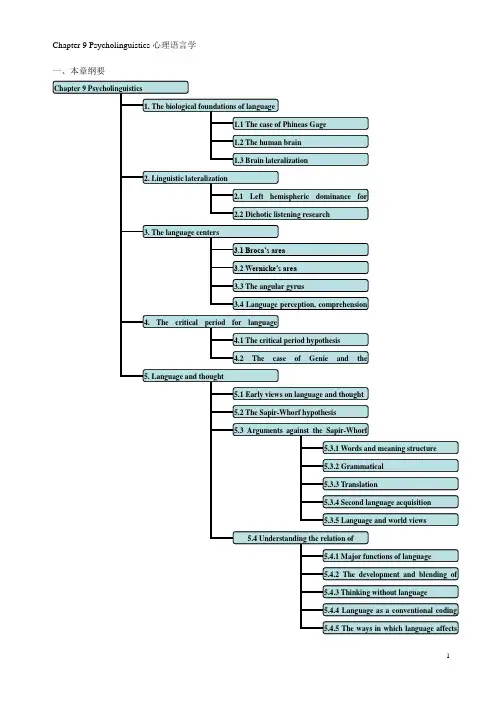
Chapter 9 Psycholinguistics心理语言学一、本章纲要二、本章重点(2005,单选;2007,名词解释) Psycholinguistics is the study of language in relation to the mind. As the term suggests, it is viewed as the intersection of psychology and linguistics, drawing equally upon the language we acquire, produce and comprehend, and the mind or brain in which our linguistic and cognitive faculties are localized and organized, and interact with each other in particular ways. Our linguistic capability depends largely on the structure and dynamics of the human brain. 心理语言学主要从心理的角度对语言进行研究,目的在于揭示人类是如何掌握语言,说出语言和理解语的,语言与思维的关系等一系列问题。
1.The biological foundations of language语言的生理基础(2005,判断)Our linguistic ability is a biological gift of the species’ gene program. 人类不需要课堂教学就可以自然习得自己的母语。
人类有语言能力的主要原因不可能是人有声带,因为其它动物也有声带。
人类的语言能力主要依赖人脑结构和人脑的机制。
人类大脑的左半球的某些区域比右大脑相应的区域要大,这是人类大脑所特有的特征。

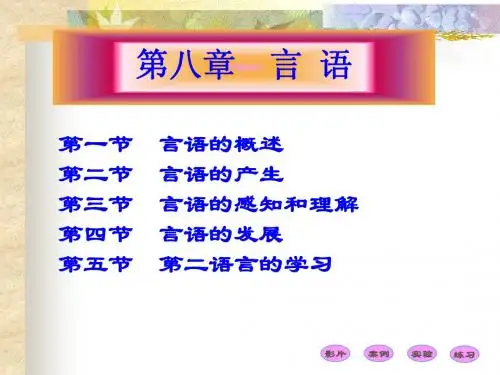
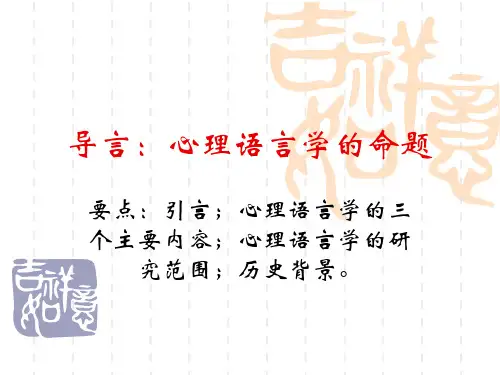
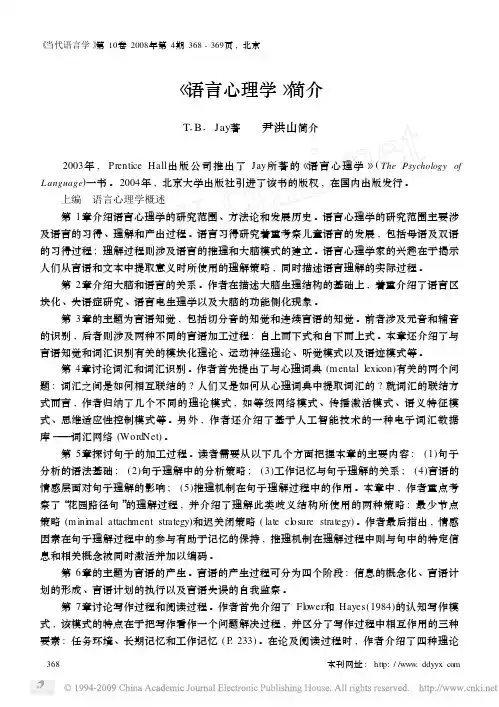
《当代语言学》第10卷2008年第4期368-369页,北京《语言心理学》简介T1B1Jay著 尹洪山简介2003年,Prentice Hall出版公司推出了Jay所著的《语言心理学》(The Psychology of L anguage)一书。
2004年,北京大学出版社引进了该书的版权,在国内出版发行。
上编 语言心理学概述第1章介绍语言心理学的研究范围、方法论和发展历史。
语言心理学的研究范围主要涉及语言的习得、理解和产出过程。
语言习得研究着重考察儿童语言的发展,包括母语及双语的习得过程;理解过程则涉及语言的推理和大脑模式的建立。
语言心理学家的兴趣在于揭示人们从言语和文本中提取意义时所使用的理解策略,同时描述语言理解的实际过程。
第2章介绍大脑和语言的关系。
作者在描述大脑生理结构的基础上,着重介绍了语言区块化、失语症研究、语言电生理学以及大脑的功能侧化现象。
第3章的主题为言语知觉,包括切分音的知觉和连续言语的知觉。
前者涉及元音和辅音的识别,后者则涉及两种不同的言语加工过程:自上而下式和自下而上式。
本章还介绍了与言语知觉和词汇识别有关的模块化理论、运动神经理论、听觉模式以及语迹模式等。
第4章讨论词汇和词汇识别。
作者首先提出了与心理词典(mental lexicon)有关的两个问题:词汇之间是如何相互联结的?人们又是如何从心理词典中提取词汇的?就词汇的联结方式而言,作者归纳了几个不同的理论模式,如等级网络模式、传播激活模式、语义特征模式、思维适应性控制模式等。
另外,作者还介绍了基于人工智能技术的一种电子词汇数据库———词汇网络(WordNet)。
第5章探讨句子的加工过程。
读者需要从以下几个方面把握本章的主要内容:(1)句子分析的语法基础;(2)句子理解中的分析策略;(3)工作记忆与句子理解的关系;(4)言语的情感层面对句子理解的影响;(5)推理机制在句子理解过程中的作用。
本章中,作者重点考察了“花园路径句”的理解过程,并介绍了理解此类歧义结构所使用的两种策略:最少节点策略(m ini m al attach ment strategy)和迟关闭策略(late cl osure strategy)。
Chapter 9Conversational InteractionsJune 1, 2010Speech production in its social context: conversation1.Lisa:Hey eva there’s something I wanted to tell you.2.Eva: mhm.3.Lisa:My brother is coming to town for a visit next week4.Eva: How nice5.Lisa:and you know, he broke up with that awful Julie “last”week6.Eva: ‘how”very nice, when’s he getting here?7.Lisa:next Monday8.Eva: Want to go shopping and help me pick out something reallyattractive before Monday?Speech production in its social context: conversationFeatures of conversationl Personnel:Participants in a conversationØSpeaker(s) and addressee(s)l Common ground: Knowledge and beliefs shared by the personnelØAssumptions about what the other(s) know(s)/ believe(s)l Action sequence: Small joint projects in a conversation ØOpening, information exchange, closingFeatures of conversationl Adjacency pair:each person contributes something to a joint project.–Agenda setting–Question-and-answer sequencel Contribution:Mutual agreement among the personnel that the addressee has understood the speaker→continue to the next joint project.What is a conversation?n Loosely structured coordinated action. Speech production in its social context.n Coordinated by conventions and negotiationØOpeningØClosingØTurn-takingØTopic selectionØParticipant determinationConversational Interactionn Conversation is a complex process of language use and a special form of social interaction with its own rules and dynamics.n Conversation is a joint action: two participants jointly follow the rules.n Conversation rules: with powerful influence of social and cultural context.Conversation as a speech eventOpening conversationsn Direct addressØHey, George!n Information request ØDo you know the time? n Offer assistanceØAre you looking forsomeone?n Stereotyped expression ØHello!ØExcuse me.n Stereotyped topicØNice weather, huh?ØCome here often?We have only a limited number of ways to open a conversation.Closing conversationsWe use preclosing statement to signal a readiness to end the conversation.n Preclosing statement:ØSooo…ØWell…(can be accepted or not)n Content summary:ØSo, we’re agreed: You’ll hide the body and I’ll distract the cops.n Justifying ending:ØI’m late for a meeting.ØI know you are busy-I’ll let you go now.Closing conversations n Expressing pleasure:ØThis was fun.n Planning future contact:ØSee you later.ØWe’ll divvy up the money on Tuesday.n Wishing well:ØTake care.ØSweet dreams.Turn-takingl One speaker at a time, but there is often overlap at the beginning and ends of turns.l Nonverbal behavior also facilitates an orderly transition from one speaker to another. (Turn-yielding signals)(1) Drop in pitch(2) Drop in loudness(3) Extension of the final syllable(4) Termination of hand gestures(5) Stereotyped expressions (you know)(6) Completion of a grammatical clauseWhat determines who speaks next? Turn taking follows three implicit rules (Sacks, et al., 1974)(1) Current speaker selects the next speaker(2) Self-selection(3) Current speaker continuesTopic selectionl Topics in conversation can be defined in terms of the intersection (overlap) of propositions across sentences.l Created through the selection of individual responsesØA: John bought a red car in Baltimore yesterday.bought (John, car); red (car); in (John, Baltimore); etc.B: I think a red car would be ugly.think (I, X); red (car); X=ugly (car)Topic selectionB: He’s not going to buy my car?ØNew Topic: sellingØA’s options(1) Respond directly –No, he didn’t like it.(2) Refer back to part of initial statement that got a response–He needed it in a hurry.(3) Give general response –It’s always tough to buy a newcar.l Multi-layer structureØCan temporarily shift to meta-layer (outside the standard conversational context)l Correcting grammar, telling jokes, storiesParticipant determination l Participants:–Speaker–Addressee–Side participantsl Additional listeners–Bystanders–EavesdroppersConversational Participantsl Common ground: shared understanding of those involved in the conversation.–Some of the common grounds is culturally based,such as cultural values, commonly held beliefs.–Other types of common ground are more personal.Friends vs. AcquaintancesPlanalp(1993):l Friends were more likely to–use profanity–laugh more often–express negative judgments–argue with one another–make joint references to themselves (we, us)l Acquaintances were more likely to use filled pauses and talk about only one topic.Friends vs. Acquaintances l Friends have (Homstein, 1985)ØImplicit openings•Hi, it’s me.ØMore common ground•Less overt explanationØMore profanityØMore jokesØMore overt negative judgmentsØMore topicsØAsk more questionsGender differencesDo rules hold equally well for mixed-genderconversations and same-gender conversations?l Zimmerman & West (1975)ØOverlapl simultaneous speech during last word of speaker’s turn(trying to get the next turn)ØInterruptionl simultaneous speech before last word of the speaker’s turn(violation of speaker’s turn)ØMinimal responsel supportive remark (e.g., uh-huh); display of interest rather thana violationGender differencesFindings:l96% of the interruptions were by male speakers.l Many of the responses by males to female topics were delayed minimal responses.l Men deny equal status to women as conversational partners with respect to the rights to the full utilization of their turns and support for the development of topics.Gender differencesl Mixed-gender conversationsØMen interrupt much more than women.ØMany delayed minimal responses by men.l Same-gender conversationsØFewer interruptions than in mixed-gender cases.ØSame interruption rate for women & menØFewer delayed minimal responsesl Parent-child conversations are similar to mixed-gender ØMany more interruptions by parentsGender differencesl Lakoff(1975)ØTag questionsl It’s kind of chilly, isn’t it?l She ate the whole pizza, didn’t she?ØHedgesl Sort ofl I guessØQuestion intonations in declarative sentences l So we will meet at 8.All more common for women than menGender differencesGender differencesGender differencel Differences in the expectations imposed on men and women result in gender-based differences inconversational style.–Men tend not to ask questions that make them appear unknowledgeable.–Women tend to use more expressive terms.–Men are more likely to interrupt.–Women tend to use a more collaborative style.Gender difference 找点空闲找点时间领着孩子常回家看看带上笑容带上祝愿陪同爱人常回家看看妈妈准备了一些唠叨爸爸张罗了一桌好饭生活的烦恼跟妈妈说说工作的事情向爸爸谈谈常回家看看回家看看哪怕帮妈妈刷刷筷子洗洗碗老人不图儿女为家做多大贡献呀一辈子不容易就图个团团圆圆常回家看看回家看看哪怕给爸爸捶捶后背揉揉肩老人不图儿女为家做多大贡献呀一辈子总操心只奔个平平安安Power differencesProblems with this kind of researchWhere do Indirect Speech Acts come from?Basic ideas of Politeness Theoryl Politeness theory is the theory that accounts for the redressing of the affronts to face posed by face-threatening acts to addressees. First formulated in 1978 by PenelopeBrown and Stephen Levinson, politeness theory has sinceexpanded academia’s perception of politeness.l Politeness is the expression of the speakers’intention to mitigate face threats carried by certain face threatening acts toward another (Mills, 2003, p. 6). Another definition is "abattery of social skills whose goal is to ensure everyone feels affirmed in a social interaction". Being polite therefore consists of attempting to save face for another.Stephen Levinsonl Research focus: language diversity and its implications for theories ofhuman cognition.l Language is the only animalcommunication system that differsradically in form and meaningacross social groups of the samespecies, a fact that has beenneglected in the cognitive sciences.His work attempts both to graspwhat this diversity is all about, andto exploit it as a way of discovering the role that language plays in oureveryday cognition.l Stephen C. Levinson is director of the Language and Cognition group at the Max Planck Institute for Psycholinguistics in Nijmegen, TheNetherlands. He received a BA in Archaeology and SocialAnthropology from the University of Cambridge and received a PhD in Linguistic Anthropology from the University of California Berkeley. He has held posts at the University of Cambridge, Stanford University and the Australian National University.l His most influential publication is probably Politeness: Universals in Language Usage which he co-authored with Penelope Brown andwhich was a seminal work in Politeness theory.l He has written extensively on pragmatics, and in particular, furthered the work of Paul Grice on conversational implicature. He describes his theories as being 'under the Gricean umbrella'.Basic ideas of Politeness TheoryBasic ideas of Politeness TheorySome simple ways to be politel Always leave the addressee an outØCan you reach the salt?l Give deference and debase selfØThese papers come from my notes of what I read. So I’m afraid that it would be an absolutely meaningless and unnecessary jobfor you to read these bulky papers. You might think it a waste oftime. I ask you not to bother yourself with these and just regardthem as traces of my work.(Conveys the absurdity of coercing compliance)l Explicitly acknowledge indebtedness and apologize.Some simple ways to be polite l Soften the requestØI sort of feel that I must tell you …ØGive me a hand if you can / when you have the time. l Indicate understanding of the size of imposition ØI wouldn’t ask you if I had any other options.How polite do you have to be?l Three factors determine the level of politeness(the amount of effort you have to put into satisfying the face desires of the addressee)(1) Relative social status of speaker and addresseel You and me(2) Amount of solidarity between the speaker and addresseel ASL and Hebrew(3) Size or risk of impositionl Can I have the salt?l Can I have your car?Have to be just polite enoughl Don’t want to undershootØGive me a letter of recommendation.l Don’t want to overshootØI’m sorry for asking and I wouldn’t do this if there was any other way, but do you have the time?。
外语教学心理学第9-15章要点第九章外语词汇教学的心理分析第一节词的结构一.词的感性基础按心理学的观点,词的结构包括两方面,一是在感知和理解口笔语时可以通过听觉和视觉听到和看到的复合刺激物;另一方面,是在口笔语中表达自己思想时可以通过发音和书写说出和写出的回答反射。
按认知理论的观点,掌握一个外语词是通过感觉登记和短时记忆储存在长时记忆中的多种编码的信息痕迹。
词的视、听和动觉结构是其感性基础。
此不仅可以感知,还可以表象出来。
词的表象:在记忆中恢复的词的形象称为词的表象。
词的心理结构中包含着词的听觉表象、视觉表现和动觉表象。
二、词义与概念(一)词的中心意义和具体意义1. 具体意义:是词对所代表客体或现象的关系。
2. 中心意义:决定于词与概括地反映着现实的相应概念之间的直接联系。
词的中心意义常被称为词的一般意义,包括词的是所有个别意义。
3. 词的中心意义与具体意义之间的关系是一般与个别的关系,亦即概念之间的从属关系。
中心意义——类概念;具体意义——种概念4. 概念的内涵和外延5. 两个概念之间的关系:从属、完全相合或同义、部分相合或交叉、互相排斥6. 概念之间的关系即为词与词之间的关系第二节词义的揭示一.不同语言的词之间的相互关系一种语言的词在多数情况下不是简单地与另一种语言的词相适应,而是在彼此之间存在着非常复杂多样的关系。
这些关系的复杂多样是由于一种语言的词所表概念系统与另一语言的词所表概念系统不是相同的。
不同语言的词所表的概念,以不同的形式反映现实。
不同语言的词不可能都是等义的,不可能完全相合而且绝对等值。
二.揭示外语词义的方法1.词汇对译的方法:只有在完全相合或等值的情况下,用翻译揭示词义才是有效的。
2. 直观手段揭示词义:有一定的效果,但也会造成误解。
●外语词实际上不应与实物直接联系,而是应与概念直接联系。
●使学生正确理解词义最合理的方法:根据词的特点,分别采用翻译、直观演示、构词分析、同义词、反义词、上下文等手段,并着重就词所表概念进行必要的讲解。
自考英语语言学复习大纲Chapter 1Introduction 绪论1.What is linguistics?什么是语言学1.1Definition:Linguistics is generally defined as scientific study of language.语言学普遍被定义为对语言进行的科学研究。
2.What is language?什么是语言?2.1Definitions:Language is a system of arbitrary vocal symbols used for human communication.语言是用于人类交流的一个任意的语音符号系统。
(1)language is a system (2)language is arbitrary (3)language is vocal (4)language is human specific Chapter 2Phonology 音位学1.The phonic medium of language 语言的语音媒介2.Phonetics 语音学 a.The study of language as a whole is often called general linguistics.普通语言学。
b.The study of sounds,which are used in linguistic communication is called phonetics.语音学c.The study of how sounds are put together and used in communication is called phonology.音位学d.The study of the way in which morphemes are arranged to form words are called morphology.形态学e.The study of how morphemes and words are combined to form sentences is called syntax.句法学f.The study of meaning in language is called semantics.语义学g.The study of meaning in context of use is called pragmatics.语用学h.The study of language with reference to society is called sociolinguistics.社会语言学i.The study of language with reference to the working of mind is called psycholinguistics.心理语言学j.The study of applications(as the recovery of speech ability)is general known as applied linguistics.应用语言学h.Other related branches include anthropological linguistics,(人类语言学)neurological linguistics(神经语言学),mathematical linguistics(数字语言学)and computational linguistics(计算机语言学).1.2The scope of linguistics 语言学的研究范畴a.语言的任意性(武断性)Arbitrarinessb.语言的能产性Productivityc.语言的双重性Dualityd.语言的移位性Displacemente.语言的文化传递性Cultural transmission1Prescriptive vs.Descriptive 规定性与描写性2Synchronic vs.Diachronic 共时性与历时性(Saussure)3Speech and Writing 口头语和书面语4Langue and Parole (both from French words)语言(抽象)和言语(具体)(Saussure)5Competence and Performance 语言能力与语言运用(Chomsky)1.3Some important distinctions in linguistics 语言学研究中的一些重要的区分2.2Design features语言的甄别性特征Hockett人类语言和其他动物的交际系统区别开来的一些特征语言学内部的主要分支跨学科分支2.1Definition:phonetics is defined as the study of the phonic medium of language.语音学关注的是语言世界中的所有声音↘three points of view 2.2Organs of speech 从三个角度审视语言的发音器官2.3Orthographic representation of speech sounds —broad and narrow transcriptions IPA-International Phonetic Alphabet 国际音标语音的正字表征—宽式标音和严式标音There are two ways to transcribe speech sounds:两种标音方法2.4Classification of English speech sounds 英语语音的分类(1)articulatory phonetics 发音语音学→研究语言的产生(2)auditory phonetics 听觉语音学→研究语言怎样被感知(3)acoustic phonetics 声学语音学→研究语音的物理属性The pharyngeal cavity 咽腔(the throat)→喉咙The oral cavity 口腔(the mouth)→嘴巴The nasal cavity 鼻腔(the nose)→鼻子One is the transcription with letter-symbols only called broad transcription.The other is the transcription with letter-symbols together with the diacritics called narrow transcription.stops 闭塞音/p/,/b/,/t/,/d/,/k/,/g/fricatives 摩擦音/f/,/v/,/s/,/z/,/ʃ/,/ʒ/,/θ/,/ð/,/h/affricates 塞擦音/tʃ/,/dʒ/liquids 流音/l/,/r/nasals 鼻音/m/,/n/,/ŋ/glides 滑音/w/,/j/bilabial 双唇音/p/,/b/,/m/,/w/labiodental 唇齿音/f/,/v/dental 齿音/θ/,/ð/alveolar 齿龈音/t/,/s/,/d/,/z/,/n/,/l/,/r/palatal 鄂音/ʃ/,/ʒ/,/tʃ/,/dʒ/,/j/velar 软腭音/k/,/g/,/ŋ/glottal 喉音/h/Front 前元音/i:/,/i/,/e/,/æ/,/a/Central 中元音/ɜ:/,/ə/,/ʌ/back 后元音/u:/,/u/,/ɔ:/,/ɔ/,/a:/close vowels 闭元音/i:/,/i/,/ɜ:/,/u/semi-close vowels 半闭元音/e/,/ɜ:/semi-open vowels 半开元音/ə/,/ɔ:/open vowels 开元音/æ/,/a/,/ʌ/,/ɔ/,/a:/Consonants 辅音in terms of manner of articulation 按照发音方式in terms of place of articulation按照发音部位Vowels元音the position of the tongue in the mouth按照舌在口腔的位置the openness of the mouth 按照嘴的张合度the shape of the lips 按照嘴唇形状the length of the vowels 按照音的长度rounded vowels 圆唇元音/u:/,/u/,/ɔ:/,/ɔ/unrounded vowels 不圆唇元音/i:/,/i/,/e/,/æ/,/a/,/ɜ:/,/ə/,/ʌ/long vowels 长元音/a:/,/ɔ:/,/ə:/,/i:/,/u:/short vowels 短元音/ʌ/,/ɔ/,/ə/,/i/,/u/,/e/,/æ/monophthong 单元音在元音中还有一些双元音(diphthong),包括:/ei/,/ai/,/au/,/əu/,/ɔi/,/iə/,/εə/,/uə/3.Phonology 音位学3.1phonology and phonetics 音位学和语音学3.2phone,phoneme,allophone 音素、音位和音位变体3.3Phonemic contrast,complementary distribution,and minimal pair 音位对立,互补分布和最小对立体3.4Some rules in phonology 3.5Suprasegmental features Chapter 3Morphology 形态学1.Definition:Morphology is a branch of grammar which studies the internal structure of words and the rules by which words are formed.形态学是语法学的一个分支,它研究的是单词的内在结构及单词的构成规律。
一.名词解释Chapter 1 Introduction引言1.linguistic语言Linguistics is generally defined as the scientific study of language.语言学一般被定义为语言的科学研究。
2.general linguistics一般语言学The study of language as a whole is often called general linguistics.作为整体而言的语言研究经常被成为一般语言学。
3.phonetics语音学The study of sounds used in linguistic communication led to the establishment of phonetics.语言交际中语音的研究导致了语音学的建立。
4.morphology形态学The study of the way in which these symbols are arranged and combined to form words has constituted the branch of study called morphology.对这些符号的排列方式和组合方式的研究构成了语言学研究的分支形态学。
5.syntax句法The study of the combination of words to form grammatically permissible sentences in languages is called syntax.句子的组合形式的研究称之为句法。
6.semantics语义学The study of meaning is known as semantics.意义的研究被称为语义学。
7.pragmatics语用学When the study of meaning is conducted,not in isolation,but in the context of language use,it becomes another branch of linguistic study called pragmatics.当意义的研究是进展的,不是孤立的,而是在语言运用的语境中,它就称为语言学的另一个分支,语用学。